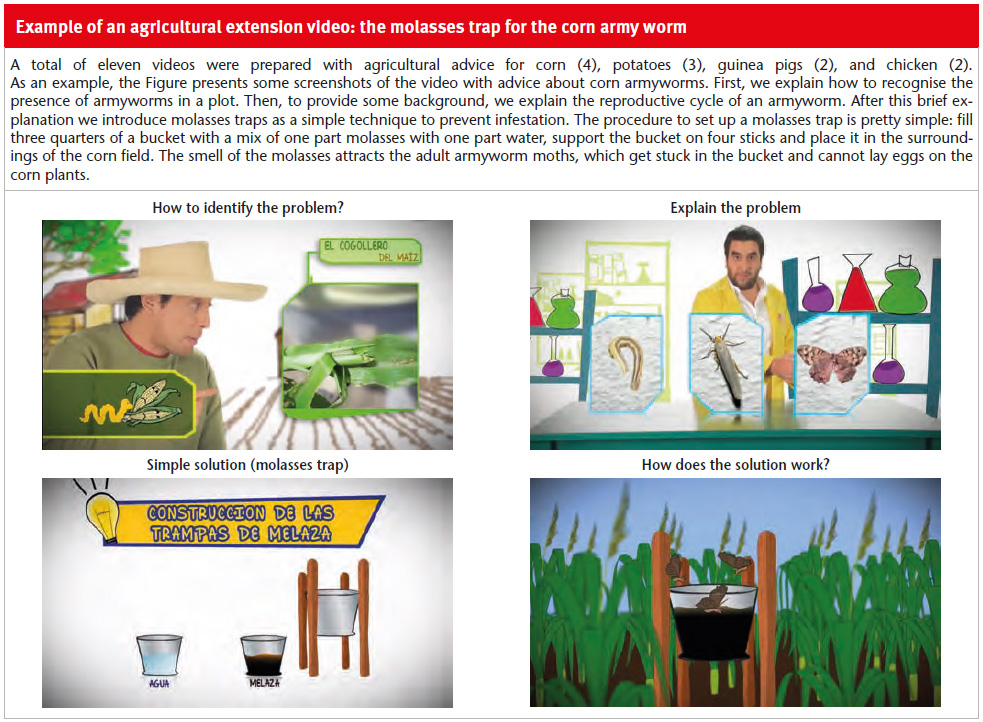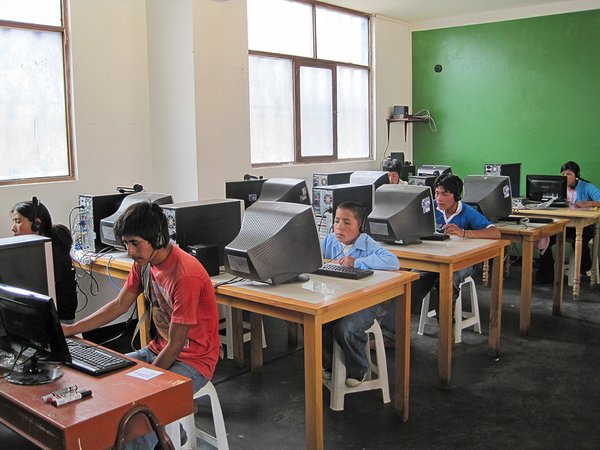 Download this article in magazine layout
Download this article in magazine layout
- Share this article
- Subscribe to our newsletter
Combining kid power and new media for agricultural extension and better health
In many development programmes, children are looked at only as potential beneficiaries. A research programme called ‘Happy Faces’, however, is studying how children themselves can be the catalysts for change. The programme explores how giving schoolchildren information can improve the health and welfare not only of children themselves, but of entire households. The advantage of working with kids is that they have a higher level of education than their parents, and it is therefore easy to transfer information to them and from them to their peers. The project team hopes that by directly targeting kids, its strategies will improve children’s and their families’ wellbeing through increased access to information. Here, we are making use of the insight that children have had a strong impact on marketing and other information dissemination strategies, such as a Thai anti-smoking campaign. But while children’s influence on adult decision-making has been studied in other disciplines for a long time, until recently, the subject has remained largely unexplored in development economics.
Level 1: From kids to kids
In the project’s first phase, researchers were curious to see if children change their own behaviour in response to simple messages given to them at school. The team found that showing public service announcements – particularly those featuring well-known personalities like soccer players – increased children’s consumption of iron supplements. The results got researchers thinking. Getting complex public health messages to rural households can be difficult and costly, often involving door-to-door campaigns. We thought, instead of going to about 100 households per village, what if we could use another way to disseminate information? Going to schools is a much cheaper way to spread a message.
To assess the causal influence on using these messages through access to computers in school of one of the most widespread micronutrient deficiencies, supplemental iron pills were made available at a local health centre in rural Peru and adolescents were encouraged to take them up via classroom media messages. In order to create experimental variation, the study used an encouragement design that randomly varied students’ exposure to promotional materials emphasising the benefits of supplementation and encouraging them to visit the clinic daily to take an iron pill. In particular, over the course of the ten-week study, students were exposed several times to one of the following three videos that lasted one to two minutes: the first video showed a popular soccer player encouraging iron supplements to maximise energy; the second showed a doctor encouraging iron supplements for overall health; and the third “placebo” video did not mention iron at all and instead featured a dentist encouraging oral hygiene. The first two videos served both to explain the benefits of iron to the children, and to remind them to take the iron pills. Each video lasted between 70 and 100 seconds, and on average, students viewed the same one of the three videos 5.75 times over the ten-week period.
Results from school administrative records provide novel evidence that reducing iron deficiency results almost immediately in a large and significant improvement in school performance. For anaemic students, an average of ten 100mg iron pills over three months improves average test scores by 0.4 standard deviations and increases the likelihood of grade progression by eleven per cent. Supplementation also raises anaemic students’ aspirations for the future. Furthermore, our results indicate that brief media messages are a highly effective means of encouraging adolescents to take advantage of supplements made available through public clinics. In 1993, the World Health Organization (WHO) recommended actions for the development of assessment, advocacy, prevention and control initiatives in most countries to reduce anaemia among adolescent girls. Yet, while effective, national Weekly Iron-Folic Acid Supplementation (WIFS) programmes are extremely costly to implement and thus out of the question in many resource-poor settings. Furthermore, even when such programmes are put into place, it may be difficult to reach adolescents who are not in school. Our results demonstrate that the passive distribution of iron supplements through health clinics can achieve very high rates of compliance among anaemic adolescents with the addition of simple, low-cost media messages delivered on a regular basis. Similar programmes could be implemented at scale in sub-Saharan Africa at a fraction of the cost of current WIFS recommendations.

Level 2: From kids to parents
So far, the idea has worked. In the second phase of the project, researchers looked to discover whether children effectively transmit information to adults in their household, and whether those adults then change their own behaviour and household decisions based on the new information. Children received lessons on diagnosing and preventing cysticercosis, an infection spread by tapeworms in raw or undercooked pork. The disease is endemic in rural areas of the northern coast of Peru and is the leading cause of adult-onset epilepsy in much of the developing world. Although many people are aware of the link between household livestock and cysticercosis, they often don’t know that the disease can lead to seizures and death or that contamination can be reduced by proper hand washing. Project researchers launched a community health campaign involving posters and free access to testing and treatment. At the same time, they used games, slideshows, and other visual aids to teach schoolchildren about the importance of testing for and preventing cysticercosis.
The results show that children talked with their parents about what they had learned, and in turn these adults demanded more testing compared to those adults who only received the community health campaign. This growing demand could lead to a fall in the levels of infected livestock and could substantially improve cysticercosis prevention.
Now, Happy Faces has again tried the same mechanism, with children being shown simple Internet messages that teach low-cost solutions to common agricultural problems found in their households’ plots. The idea behind this is that if children pass on these messages to their parents, they could play a vital role in resolving these problems and in improving their family’s agricultural productivity and nutrition at a very small cost. This is especially interesting where traditional extension programmes are plagued with high costs of reaching isolated areas.
For this purpose, we set up a field experiment in a rural high school of Peru where half of the students were assigned to watch agricultural extension videos explaining simple and inexpensive farm management practices. The other half of the students in the school were assigned a placebo video encouraging oral hygiene and provided a control group for our intervention. Students watched these videos (individually) in the school’s computer lab during eight months. By the end of our field experiment, we collected a survey among the managers (usually the students’ parents) in charge of the students’ household farms. The survey gauged farm managers’ knowledge and adoption of the agricultural practices taught to the students through the videos.

We found that farm managers of households with students that were assigned to watch the extension videos were more knowledgeable. On average, their probability of knowing about agricultural practices increased by 33–50 per cent, compared to farm managers with students in the control group. Even when parents did not directly receive information about agricultural practices, students were able to convey the information they had received.
Albeit more modest, we also found positive effects in the adoption of agricultural practices taught in the videos among households with students who were provided with extension advice. And we investigated whether our intervention had heterogeneous effects, and found that increases in knowledge and adoption rates were significantly higher among younger and more educated farm managers. We also found some support for stronger flows of information between children and parents of the same gender (i.e. fathers-sons and mothers-daughters).
Due to the high costs of traditional extension systems, there is an increasing interest to adopt Information and Communication Technologies (ICTs) to provide farmers with agricultural advice. However, large levels of ICT illiteracy among farm managers in developing countries have thwarted this interest. Our research shows an innovative solution to bypass this constraint by channelling information through (more ICT-literate) children in their households. Additionally, while Happy Faces has focused on the potential role of upper intergenerational transmission of information to provide agricultural extension, this mechanism can potentially have many other applications. While more research is required, ICT-based information campaigns that target children are in principle suitable to indirectly provide adults with information and alter their decisions, and we are now convinced that this could be scaled up to sub-Saharan Africa.
Maximo Torero
Executive Director at the World Bank
Washington D.C., USA
mtorero@worldbank.org
References and links
- Chong, A; Cohen, I; Field, E; Nakasone, E; and Torero, M. (2016). Iron Deficiency and Schooling Attainment in Peru. American Economic Journal: Applied Economics 2016, 8(4): 222–255.
- Nakasone, E. and Torero, M. (2017). Agricultural Extension through Information Technologies in Schools: Do the Cobbler's Parents go Barefoot?
http://ageconsearch.umn.edu/bitstream/236114/1/Nakasone%20and%20Torero%20-%20Ag%20Extension%20through%20ITs.pdf - Thai anti-smoking campaign (video on Youtube)





Add a comment
Be the First to Comment